Gillings outlines the mathematical practices, procedures and arithmetic techniques used by the Ancient Egyptians. This is done through providing examples of all its aspects : additions, multiplications, fractions, etc.
A standard Egyptological reference work, it is recommended reading for all involved in the subject of mathematics and who have an interest in its evolution and history in Ancient Egypt.
for math lovers
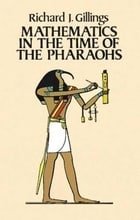 Posted : 17 years, 10 months ago on 9 June 2007 12:15
(A review of Mathematics in the Time of the Pharaohs)
Posted : 17 years, 10 months ago on 9 June 2007 12:15
(A review of Mathematics in the Time of the Pharaohs) 0 comments, Reply to this entry
0 comments, Reply to this entry
easy to read, and rather interesting
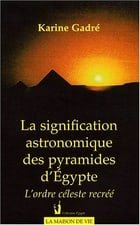 Posted : 17 years, 10 months ago on 9 June 2007 12:10
(A review of La Signification Astronomique des Pyramides d'Égypte. L'ordre céleste recréé)
Posted : 17 years, 10 months ago on 9 June 2007 12:10
(A review of La Signification Astronomique des Pyramides d'Égypte. L'ordre céleste recréé)Written by a French astrophysician, this book tries to resolve a few problems which the pyramids of Egypt pose.
The author first describes the Ancient Egyptians' world through the sky and their beliefs in it, as well as their conception of the universe, and then goes on to explain the meaning of the pyramids.
This is an easy book to understand, despite the few technical and astronomical terms in the concluding chapters.
-------------
C'est un livre facile à lire malgré les quelques termes astronomiques des derniers chapitres. Ce livre associe une signification astronomique aux pyramides différente de celles connues jusqu'à maintenant.
The author first describes the Ancient Egyptians' world through the sky and their beliefs in it, as well as their conception of the universe, and then goes on to explain the meaning of the pyramids.
This is an easy book to understand, despite the few technical and astronomical terms in the concluding chapters.
-------------
C'est un livre facile à lire malgré les quelques termes astronomiques des derniers chapitres. Ce livre associe une signification astronomique aux pyramides différente de celles connues jusqu'à maintenant.
 0 comments, Reply to this entry
0 comments, Reply to this entry
easy to read
 Posted : 17 years, 10 months ago on 8 June 2007 11:09
(A review of The Secrets of the Sphinx: Restoration Past and Present (English and Arabic Edition))
Posted : 17 years, 10 months ago on 8 June 2007 11:09
(A review of The Secrets of the Sphinx: Restoration Past and Present (English and Arabic Edition))Written in both English and Arabic, this book nicely presents the past and present history of the Sphinx.
The author presents his own theory regarding the time of its construction and the source of its weathering. In doing so, he argues strongly against the hypothesis advanced by geologist Robert Schoch and author John Anthony West.
With many photographs, this is a good overview of this famous ancient Egyptian monument, for it is easy to read and understand.
The author presents his own theory regarding the time of its construction and the source of its weathering. In doing so, he argues strongly against the hypothesis advanced by geologist Robert Schoch and author John Anthony West.
With many photographs, this is a good overview of this famous ancient Egyptian monument, for it is easy to read and understand.
 0 comments, Reply to this entry
0 comments, Reply to this entry
outdated, but still useful
 Posted : 17 years, 10 months ago on 8 June 2007 11:05
(A review of The obelisks of Egypt: Skyscrapers of the past)
Posted : 17 years, 10 months ago on 8 June 2007 11:05
(A review of The obelisks of Egypt: Skyscrapers of the past)The history of each existing obelisk is explained informatively and in vivid detail by the author.
Well written, although out-dated a little, it is a must read for all obelisks buff.
Well written, although out-dated a little, it is a must read for all obelisks buff.
 0 comments, Reply to this entry
0 comments, Reply to this entry
for the interested
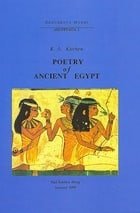 Posted : 17 years, 10 months ago on 8 June 2007 01:56
(A review of Poetry of Ancient Egypt (Documenta Mundi Aegyptiaca 1))
Posted : 17 years, 10 months ago on 8 June 2007 01:56
(A review of Poetry of Ancient Egypt (Documenta Mundi Aegyptiaca 1))This book, presented in phonetic Ancient Egyptian and its English translation, covers select poetry from the First Dynasty down into Graeco-Roman times.
The examples given include praises of the pharaohs, love lyrics and hymn to the gods. Included are very useful endnotes.
The book is an interesting concept and the only criticism that can be made is that it has no illustrations of the texts mentioned.
All in all, it is recommended for the interested in literature of Ancient Egypt.
The examples given include praises of the pharaohs, love lyrics and hymn to the gods. Included are very useful endnotes.
The book is an interesting concept and the only criticism that can be made is that it has no illustrations of the texts mentioned.
All in all, it is recommended for the interested in literature of Ancient Egypt.
 0 comments, Reply to this entry
0 comments, Reply to this entry
interesting travels
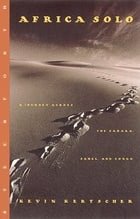 Posted : 17 years, 10 months ago on 8 June 2007 01:55
(A review of Africa Solo: A Journey Across the Sahara, Sahel and Congo)
Posted : 17 years, 10 months ago on 8 June 2007 01:55
(A review of Africa Solo: A Journey Across the Sahara, Sahel and Congo)Falling under the wide-ranging scope of travel literature, this entertaining and informative book expands on the author's experiences during a journey through the African continent in the late 1980s : he visits the countries of Algeria, the Central African Republic, the Congo and Zaire, as well as the Sahara desert.
Cars, boats, planes and the author's own two feet were his means of locomotion, meeting interesting people along the way from natives to foreigners like himself.
The story he tells is related in a comprehensible style.
Cars, boats, planes and the author's own two feet were his means of locomotion, meeting interesting people along the way from natives to foreigners like himself.
The story he tells is related in a comprehensible style.
 0 comments, Reply to this entry
0 comments, Reply to this entry
recommended book
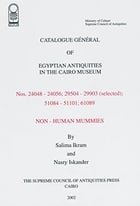 Posted : 17 years, 10 months ago on 8 June 2007 01:53
(A review of Statues of the Xxvth and Xxvith Dynasties: Catalogue General of Egyptian Antiquities Nos. 48601-48649 (Supreme Council of Antiquities Books))
Posted : 17 years, 10 months ago on 8 June 2007 01:53
(A review of Statues of the Xxvth and Xxvith Dynasties: Catalogue General of Egyptian Antiquities Nos. 48601-48649 (Supreme Council of Antiquities Books))From the introduction to the last page, this catalog is the witness of this period, qualified as 'purely Egyptian in style.'
The last paragraph of the introduction says a great deal about this most interesting catalog; the author suggests that scholars should show more interest in this particular period.
When reading through this catalog, the reader will wish indeed that scholars show this interest.
Through the well-documented pages appears a rich era. All inscriptions are well explained and all statues described with much detail.
Wonderful photographs complete this recommended book.
The last paragraph of the introduction says a great deal about this most interesting catalog; the author suggests that scholars should show more interest in this particular period.
When reading through this catalog, the reader will wish indeed that scholars show this interest.
Through the well-documented pages appears a rich era. All inscriptions are well explained and all statues described with much detail.
Wonderful photographs complete this recommended book.
 0 comments, Reply to this entry
0 comments, Reply to this entry
for those interested in Ancient Egypt
 Posted : 17 years, 10 months ago on 8 June 2007 01:23
(A review of A Short History of Ancient Egypt: From Predynastic to Roman Times)
Posted : 17 years, 10 months ago on 8 June 2007 01:23
(A review of A Short History of Ancient Egypt: From Predynastic to Roman Times)This book provides an accurate description of ancient Egyptian history, as it is currently known and recognised.
Dividing chapters in dynasties' history, the author tells about the development of this fascinating culture.
Accompanied by wonderful color photographs and maps, this is an excellent introduction for beginners to the introduction to the history of ancient Egypt, from Predynastic times to the Roman period.
Dividing chapters in dynasties' history, the author tells about the development of this fascinating culture.
Accompanied by wonderful color photographs and maps, this is an excellent introduction for beginners to the introduction to the history of ancient Egypt, from Predynastic times to the Roman period.
 0 comments, Reply to this entry
0 comments, Reply to this entry
for children ages 9 to 12
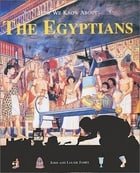 Posted : 17 years, 10 months ago on 8 June 2007 01:22
(A review of The Egyptians)
Posted : 17 years, 10 months ago on 8 June 2007 01:22
(A review of The Egyptians)The book's brief chapters deal with various aspects of life in Ancient Egypt including hunting, trade, farming, and family.
They also describe the society in which the Ancient Egyptians lived, the work involved, the scribes and the pharaohs.
A short overview of Egyptian history and its dynasties is provided. A glossary explaining the terminology is included.
Beautifully illustrated, this is a wonderful introduction to Ancient Egypt for children ages 9 to 12.
They also describe the society in which the Ancient Egyptians lived, the work involved, the scribes and the pharaohs.
A short overview of Egyptian history and its dynasties is provided. A glossary explaining the terminology is included.
Beautifully illustrated, this is a wonderful introduction to Ancient Egypt for children ages 9 to 12.
 0 comments, Reply to this entry
0 comments, Reply to this entry
essential reference
 Posted : 17 years, 10 months ago on 8 June 2007 01:18
(A review of The Myth of Egypt and Its Hieroglyphs in European Tradition (Princeton Paperbacks))
Posted : 17 years, 10 months ago on 8 June 2007 01:18
(A review of The Myth of Egypt and Its Hieroglyphs in European Tradition (Princeton Paperbacks))Throughout the ages the hieroglyphs of the Ancient Egyptians were a treasure-trove for the imaginative creators of European literature, art, religion and philosophy, in both a practical and theoretical sense. This story of 'the myth of Egypt' is conveyed in a lucid fashion.
From the medieval, the Renaissance and the Baroque eras radiated the misconception of allegorical hieroglyphs and of Ancient Egypt being the reserve of ancient mystic knowledge. Ironically it was this very misguided train of thought which created the foundation from which the science of Egyptology would later arise, starting primarily with the decipherment of the hieroglyphs by Jean-François Champollion (the subject of the final chapter).
The author vividly and accurately reconstructs the historical contexts surrounding these events, making it an essential reference for students and academics alike.
From the medieval, the Renaissance and the Baroque eras radiated the misconception of allegorical hieroglyphs and of Ancient Egypt being the reserve of ancient mystic knowledge. Ironically it was this very misguided train of thought which created the foundation from which the science of Egyptology would later arise, starting primarily with the decipherment of the hieroglyphs by Jean-François Champollion (the subject of the final chapter).
The author vividly and accurately reconstructs the historical contexts surrounding these events, making it an essential reference for students and academics alike.
 0 comments, Reply to this entry
0 comments, Reply to this entry
 Login
Login
 Home
Home 10 Lists
10 Lists 583 Reviews
583 Reviews Collections
Collections